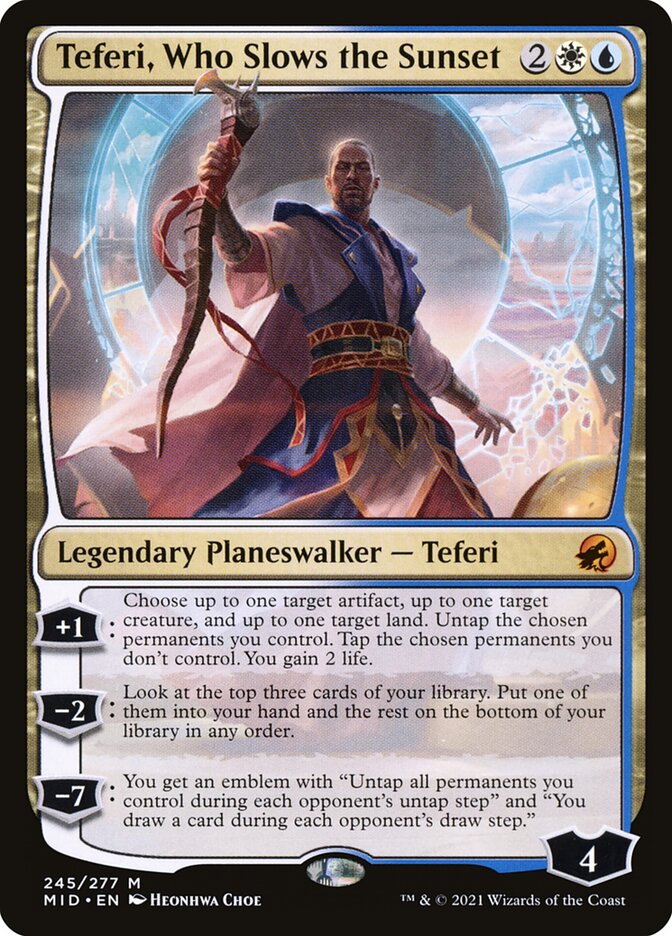While it took a few sets for Planeswalkers to make a mark on Magic the Gathering as a game, Planeswalkers have been some of the most powerful, iconic and game warping cards in Magic’s history. Across all nearly all formats, Planeswalkers have made their mark. In this article, I’ll be discussing the 10 best Planeswalkers in Modern for 2020.
10. Karn, Great Creator
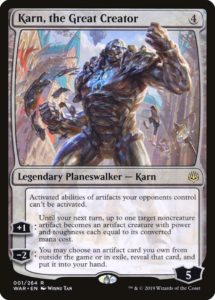
Karn, Great Creator was, in early 2020, one of the most played spells in modern and has made itself a staple in Tron. Karn was at one time such a problem that it had to have it’s combo piece, Mycosynth Lattice, banned from modern.
Karn, Great Creator, is a 4 CMC 5 Loyalty colourless Planeswalker. Being from War of the Spark, he has a passive effect and this was what got Mycosynth Lattice banned. Activated effects of artifacts your opponent controls cannot be activated. Artifacts are reasonably common in modern so he’s still useful, but this isn’t his main application. The reason this used to be a massive problem was that Mycosynth Lattice turned everything on board into an artifact and everything in hand colourless. This shut down all of your opponents activated abilities. As soon as both were on the board, which was doable by turn 5. This is inclusive of planeswalker abilities too.
-
First Ability:
Karn’s +1 turns one of your artifacts into an artifact creature with power and toughness equal to it’s CMC until your next turn. This can be useful, but not the reason you’d use Karn. His -2 is.
-
Second Ability:
Karn’s -2 is probably one of the most versatile abilities of the entire game. Get an artifact from your exile or sideboard. The point of a sideboard is to adapt to specific matchups, so being able to do that at will is by it’s own nature is incredibly powerful. Grafdigger’s Cage, Ensnaring Bridge, Liquidmetal Coating, Pithing Needle, Relic of Progenitus, Sundering Titan, Trinisphere, further copies of Walking Ballista and Wurmcoil Engine are all common sideboard options in Tron and can deal with a wide variety of situations. WIth these, the Tron can deal with graveyard decks, decks very low to the ground, decks focusing on activated abilities, decks that focus on bombs, a whole variety of decks.
War of the Spark was probably one of the most powerful sets in regards to Planeswalkers, which is unsurprising, it does have 39 of them. Some were going to have massive impact. Karn, Great Creator is one of those cards.
9. Chandra, Torch of Defiance

Chandra, Torch of Defiance was a major player in Standard back in 2017 till she was rotated out, part of the mono-Red Aggro deck of the time. Since then, Chandra has found a home in Modern Gruul (Red/Green) midrange decks due to her versatility.
-
First Ability:
Chandra, Torch of Defiance is a Red 4 CMC (Converted Mana Cost) 4 Loyalty Planeswalker. Though she looks to have a whopping four abilities like the iconic Jace, the Mind Scultor, she techically surpasses him in having five abilities. This is because of her first +1 is modular. Exile the top card of your deck, you may cast it. If you do not, she deals 2 damage to all opponents. If it’s something you don’t want to cast, can’t cast or you just need to hit your opponent for 2 damage to win, she does that. Otherwise, she’s straight card advantage and that’s always a positive, especially in Red focused decks that run through hand quickly.
-
Second Ability:
Her second +1, because Chandra has two, is a ritual-type effect, two Red mana. Get you casting more per turn, ramp into higher cost spells, in particular Glorybringer, a 5 CMC 4/4 Dragon with flying and haste that can exert itself when it attacks, choose not untap at it’s owners next untap phase, to deal 4 damage to target non-Dragon creature. Ramp into strong control or just a flyer with haste.
-
Third Ability:
Chandra’s -3 allows her to hit a creature for 4 damage. In Gruul you have Lightning Bolt, which Chandra can help you to get to, and the aforementioned Glorybringer. While Chandra’s -3 can get rid of things if you’re in a bind, you do have other options to do it.
-
Fourth Ability: Ultimate
Finally, Chandra’s Ultimate is a -7, her third turn of being on the board minimum. You get an Emblem that deals 5 damage to target creature or player when you cast a spell. This is a game ender. You’ve been either gaining a card or hitting them for 2 damage from the moment she hit the board, on top of everything else your deck is doing, just one spell and this emblem is likely enough to end it if the game has gone on long enough for the Emblem to see play.
Chandra, Torch of Defiance is not the most powerful Planeswalker in Modern, but she is by far one of the most versatile. Hand advantage, burn, creature destruction and rituals, she does a lot and that’s what earns her a place not only in the Gruul deck, but on this list.
8. Ugin, the Spirit Dragon
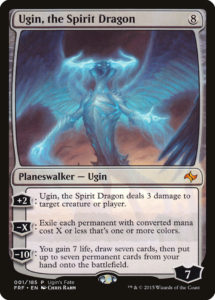
To talk about Ugin, the Spirit Dragon, we must look further at the deck it has a home in, Tron. Tron itself is an interesting deck in that while it’s core pieces, the Urza Lands, have existed since Antiquities, one of the earliest sets in 1994, the deck never really became a thing until Eighth Edition’s reprints of those cards 9 years later. The Urza Lands are a set of three lands with an synergistic gimmick. Urza’s Mine provides 1 colourless mana, but provides 2 if you control Urza’s Power Plant and Urza’s Tower. Urza’s Power Plant is a similar deal, provides 1 colourless mana, if you control Urza’s Tower and Urza’s Mine, it provides 2 instead. Urza’s Tower is the outlier. It too provides 1, but if you control both Urza’s Mine and Urza’s Power Plant, it provides 3 colourless mana. If you get to all three by turn 3, which the deck aims to do, you have 7 colourless mana. This makes Ugin not the 8 drop colourless Planeswalker it appears to be, but a 4 drop colourless Planeswalker.
-
First Ability:
Ugin, Spirit Dragon has 7 Loyalty. His +2 is a slightly toned down Lightning Bolt. 3 damage to target creature or player. Can’t hit Planeswalkers, but it goes without saying how strong this is. Short of fatter creatures, Ugin, as a plus, can kill most things or just go for the jugular with burn damage. 3 is a decent chunk of burn too and considering the deck has Walking Ballista, another card that can inflict burn damage, Tron can close out the game on will.
-
Second Ability:
Ugin has a -X ability, instead of a static number. Exile each permanent with a converted mana cost of X that has a colour, so no colourless cards. Tron is mostly an artifact / colourless deck, so it’s essentially immune to this, but this does get rid of the planeswalkers that Ugin simply can’t deal with any other way.
-
Third Ability: Ultimate
Ugin’s Ultimate is a -10, which is the third turn he is out if you keep using his +2 and leaves him with 1 Loyalty. It gives you 7 life, draws you 7 cards and then you may put 7 permanent cards from your hand into play. More creatures, lands, artifacts, all of them. Massive field advantage without losing Ugin, provided you keep him safe.
Ugin is a very bunt card with little to discuss. He just comes out, does his thing, is very good at it, but is a payoff to the Urza Lands, nothing about his effects are synergistic. He is very good though, more so when you consider he is a 4 drop within the context of his deck.
7. Wrenn and Six
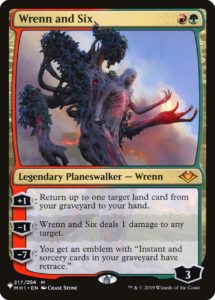
Modern Horizons had quite the effect on Modern, which was the point. The set was designed to bring new cards into Modern directly and shake up the format. The set was so effective at it that two cards from it had to be banned within 11 months from it’s release, one of those, Hogaak, Arisen Necropolis, was banned within 2 months. Modern Horizons also brought us a few new planeswalkers, including Wrenn and Six.
Not much is known about Wrenn and Six other than Wrenn is a Dryad and she is somehow bound to the Treefolk Six as sometype of Treefolk biosuit. Wrenn and Six are a 2 CMC Red Green planeswalker with 3 Loyalty. Two cost planeswalkers are usually very bad, such as the infamous Tibalt, but being on this list means Wrenn and Six are far from bad.
-
First Ability:
Wrenn’s +1 is to return a land from your graveyard to your hand. Any land. This actually makes Wrenn rather expensive to run because it’s most useful application is with the ever so desirable Fetch Land. Play the Fetch Land, crack it, get your new Land, Wrenn gives you back your Fetch Land. This effect gives three benefits; 1 A consistent stream of Lands, 2 The ability to always get the exact colours you need, 3 Thin your deck every turn, making it slightly easier to draw the cards you need and not Lands. There are also further applications in Wrenn’s colours of Red and Green. Green can tutor lands, most of the time to hand, sometimes to the grave. Red has spells and effects that draw and discard cards. If you discard Lands or put them into your gave with your effects, Wrenn can get them back. Wrenn’s +1 is incredibly useful.
-
Second Ability:
Wrenn’s -1 pings any target. Can be very useful for getting rid of small creatures, typically with very annoying effects or could take down Wrenn during your opponent’s next turn. It’s a fine effect, especially for Wrenn’s speed, but not as interesting as Wrenn’s first effect.
-
Third Ability:
Wrenn’s Ultimate is a -7 that gives you an emblem that gives the Instants and Sorceries in your Graveyard Retrace, an effect from 2008’s Eventide and only a one off Commander card since. Retrace is the precursor to Guild’s of Ravnica’s Jump-Start and an evolution of the much older Flashback. With the additional cost of discarding a Land, you can cast a card with Retrace from your Graveyard. Retrace is much stronger than the later Jump-Start in spite of the much more restrictive discard as the card isn’t exiled after it is cast. Wrenn’s Ultimate is quite obviously positioned to play off her +1. By the time you go into her Ultimate, you should have drawn a few lands naturally and can just pitch those.
Wrenn and Six is a really good card. She’s designed with a clear interaction in mind and is quite effective at it.
6. Ashiok, Dream Render

Ashiok, Dream Render is the most commonly played Planeswalker of 2020. A 3 CMC 5 Loyalty Black Blue Planeswalker, Ashiok is versatile in that it has hybrid Black Blue Mana. So long as you’re running Black or Blue mana, you can run Ashiok.
-
First Ability:
Being a War of the Spark Planeswalker, Ashiok comes packed with a passive ability. Your opponent cannot search their library via their own effects. Your opponent cannot tutor or selectively dump things into their grave. This is restricted a bit in that it’s their abilities, so you can’t just chuck Ashiok in White Blue, cast Path to Exile and block the Land search effect. Saying that, no Fetchlands alone is horribly terrifying. Those don’t even provide Mana if you can’t crack them and they are a modern staple. Many decks tutor cards as well, Ashiok says no.
-
Second Ability:
That’s kind of Ashiok’s theme, it says no. It’s -1 mills a player 4 cards, then exiles your opponent’s graveyards. The wording here is what makes Ashiok good. If you’re running a grave based deck, such as Golgari (Black/Green) or Jund (Black/Red/Green) not only does Ashiok naturally splash in, it starts setting you up while removing your opponent’s graves. Removing the grave is always a good thing to do since so very much interacts with it.
There is also the mill choice for Ashiok, though this is a far less popular option. Mill your opponent 4, then remove their grave to prevent them from using it. With 5 loyalty, you get a total of 20 cards milled over 5 turns before you need to play another Ashiok, which will raise your mill to 24 over 5 turns, in addition to whatever else you’re doing. By that time, you should have milled them out if that is the gameplan you’re going for and it’s successful.
Ashiok is probably not main deck material for most, it’s very much dependant on matchup how much milage it will give you, but it is a very good Planeswalker.
5. Teferi, Hero of Dominaria

Wizards has something of a nack for taking popular blue characters and making them reviled by the community. There was once a time when Jace was the most popular of the Lorwyn five and the face of Magic the Gathering, then after the infamous Jace the Mind Sculptor happened and Wizards seemingly overdosed the game on Jace. People grew very tired of him. Now Jace is a rarely used planeswalker. Teferi is a much older character, originally from 1998’s Urza’s Saga and stayed as a major player in the game till 2006’s Time Spiral, with the exception of supplementary products. With 2018’s Dominaria, Teferi would return with quite a different design and a very annoying card.
-
First Ability:
Teferi, Hero of Dominaria is a 5 CMC Blue White Planeswalker with 4 Loyalty. His +1 draws you an extra card and untaps 2 Lands during your End Phase. The +1 card in hand is always useful, it can’t be understated, but in tandem with the untap, it’s exceptionally good. Most instants commonly played, especially commonly played Counterspells cost 2, as do many other reactionary instants. Your opponent’s plays will change on their turn because of that constant looming threat of a Dovin’s Veto or Seal Away. On further turns, it’s just a raw +1 and essentially a 2 mana ramp.
-
Second Ability:
Teferi’s -3 is so good, it’s actually worth dropping him to 1 Loyalty on some turns he comes out. It’s a super powered Spin. (Spin is YGO slang for placing a card from the field to the top of the deck.) Put a non-land permanent third from the top of it’s owners deck. Not only is it gone, they can’t cast it next turn and they don’t even draw it. Just short of ‘tucking’, shuffling permanents into it’s owner’s deck or putting them on the bottom of their owner’s deck, this is one of the most effective forms of removal. The card dealt with is now far more inaccessable than straight killing.
-
Third Ability: Ultimate
Teferi’s ultimate might be hard to get off at 8, especially in modern, 4 turns to get their without assistance, but it is exceptionally powerful. You get an emblem that gives you the effect of whenever you draw a card, exile target permanent an opponent controls. This effect is completely unregulated. Not your draw phase, every single draw. He’s in Blue, you probably are drawing more than your draw phase. Not a permanent, an opponent’s permanent, so he doesn’t backfire and can hit lands. Exile is hard to interact with, just like the deck.
Teferi is an amazingly strong card, both for his colours and the format. But it only gets better from here.
4. Karn, Liberated

Karn, Liberated has been a staple of Tron since it’s release in 2011’s New Phyrexia and the deck now runs both Karn, Liberated and Karn, Great Creator. Karn Liberated is a 7 CMC 6 Loyalty colourless Planeswalker, except it’s not. It’s a 3 CMC Planeswalker due to the Urza Lands talked about earlier with Ugin, Spirit Dragon. Karn being 7 actually makes him much better than Ugin since as if you get to all three Urza Lands by turn 3, which again, the deck aims to do, you have 7 colourless mana. This makes Karn, a 3 drop.
-
First Ability:
Due to Karn’s high cost and likely because he wasn’t designed with the Tron Lands in mind, his plus ability is a massive +4 and a particularly strong one. Target player exiles a card from their hand. While your opponent gets to choose, it’s one sided, exile is one of the most permanent forms of removal and Karn is hitting the board very early. The longer this goes on and the more you use other forms of removal deal with their board, the more limited their options become. Karn is also a wopping 10 loyalty after one use and despite being colourless, he’s not an artifact, which makes him incredibly hard to deal with short of straight Planeswalker hate.
-
Second Ability:
Karn’s -3 deals with something if it’s hit the board for whatever reason. Exile target permanent. No restriction on what he can target, including Lands and he only gets down to 3. He puts your opponent at a massive disadvantage and is still not that easy to deal with. A well timed Lightning Bolt is about it early on.
-
Third Ability: Ultimate
Karn’s Ultimate is a -14, which isn’t even a big deal since he essentially can start at 10 and jump to 14 on the very next turn. He restarts the game and all non-Aura permanents exiled by that Karn Liberated stay in exile, then you get them on your board when the new game starts. If you use two Karn Liberated over the course of a game, only the cards exiled by the Karn that used the ultimate come under your control. This is very powerful. Even though you might use it sparingly, it’s still insane. The rather interesting thing is, if the game was slower, you could exile your own Urza Lands, then restart the game with all three in play, drop a 7 drop in from turn 1, if not worse, but the general use is to start with all of your opponents permanents that you exiled. The fact is though, both of the first two parts of Karn are just more desirable. This is more of an emergency button effect.
Karn, Liberated is by far the best removal on this list. Big, bulky, solid and fast, gets rid of things in a way your opponent can’t really interact with them. Much like Ugin, he’s just not as synergistic as other cards on this list since he himself is a payoff.
3. Liliana of the Veil
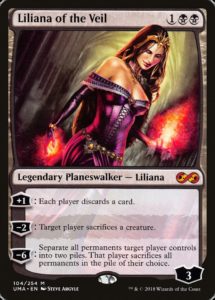
Liliana of the Veil is one of the most iconic Planeswalker cards of all time, along with the infamous Jace the Mind Scupltor, and has been highly desirable since her release in Innistrad back in 2011. She’s both a very popular character and a powerful card.
-
First Ability:
Liliana of the Veil is a 3 CMC 3 Loyalty Black Planeswalker with a hard control theme. Her +1 causes both players to discard a card. In the Jund deck Liliana is most commonly played in, this is used to fuel Tarmogoyf, who gets stronger for each card type in all graves. It is also comboed with Kroxa, Titan of Death’s Hunger who wants to be in the Graveyard to Escape, a mechanic where it can be played from the Graveyard. Finally, in combination with Wrenn and Six, a card also on this list, Lily’s +1 can be used to just give your opponent a -1 from their hand. Pitch a land for Liliana, get it back with Wrenn. Liliana will always take your opponent’s hand down 1, but your discard will likely be advantageous or negated.
-
Second Ability:
Liliana’s -2 forces your opponent to sacrifice a creature. While good for killing their sole creature if they have one and it is a threat to Lily, it also bypasses Hexproof. While not targeting could be seen as a contributing factor to making this effect look less desirable, Jund runs very early game hand control, you can force them into a situation where they’re sacrificing their only creature.
-
Third Ability: Ultimate
Liliana’s Ultimate is a -6 that forces all opponent’s permanents into two piles, then they sacrifice one of the piles. If Lily gets to her ultimate, the Jund player has been spending all game removing their opponents resources and gotten possibly up to a 4 for 1 off of Liliana herself. They’ve also been expending what resources they have to try to deal with Liliana, her Ultimate just decimates whatever they have left.
Liliana is quite interesting compared to other Planeswalkers. Where other planeswalkers fall out of favor over time, Liliana stays relevant and will likely always be relevant. In spite of 9 years of power creep, Lily stays relevant because of her +1. She keeps getting new toys. So long as Wizards of the Coast prints things that interact with the grave, which they will, Liliana will be relevant.
2. Jace, the Mind Scupltor

2010’s Jace, the Mind Scuptor is one of the most infamous cards in Magic history. Jace is one of two cards on this list banned from their time in Standard. Jace was banned from Standard in June of 2011, 16 months after it’s release. He was actually banned from Modern in August of 2011, being unbanned in February of 2018, just short of 7 years later. Jace is considered to be the most powerful planeswalker card of all time by many people, though recent power creep has arguably given him a fight for that title.
-
First Ability:
Jace is 4 CMC 3 Loyalty Blue Planeswalker with four effects, something that was planned from the start, but a rarity at the time and still is. His +2 effect is arguably his strongest and changes quite significantly depending on how it’s used, being two keywords in one effect. You target a player, look at the top card of their deck, then you may place it on the bottom of their deck. If you target yourself, which you should never, ever do, it’s Scry. The reason you should never target yourself is because if you target your opponent, it’s Fateseal, a keyword that hasn’t been printed since 2007’s Future Sight and has an 8 on the Storm Scale. You can give your opponent dead draws. They know exactly what you’re doing too, which makes it much more painful to play against. If you send it to the bottom, they know they lost something they need. If you don’t, they know they’re drawing a dead card next turn. It’s a horribly oppressive keyword that has been abandoned for very good reasons. Most turns, you will be doing this.
-
Second Ability:
His 0 is a +1 and massive hand filter. Draw 3 cards, place any 2 from your hand on top of your deck. You can choose those 2 cards from anything you hold and set up your next draw. Might not need something now, but want it? Leave it for next turn. The first effect takes priority because of it’s devastating effect on your opponent, but this would have been a fine choice on any other planeswalker. That’s how strong Fateseal is. A +1 and massive hand filter is not the optimal effect to use.
-
Third Ability:
Same goes for his -1. It’s a fine effect, but the +2 is just better. Bounce a creature. Removal, even though it is sorcery speed, just isn’t as good as Fateseal. There are scenarios where it will be used, get rid of something that can kill Jace, but Fatesealing is just the better option in most scenarios.
-
Fourth Ability: Ultimate
Jace’s ultimate is the only effect that can compare to his +2 Fateseal. -12 to essentially win the game. Your opponent’s deck is exiled, then their hand becomes their deck. This is likely around turn 10 minimum without assistance, but by then your opponent’s hand is only a couple of cards or just dead cards you’ve forced them to draw via Fateseal. You win. While your opponent needs to deal with Jace immediately because of his +2 Fateseal effect, if Jace is just allowed to do what he does, it’s over and quite literally to. Jace could have just been his first effect and his ultimate and he would have arguably been just as strong.
Jace, the Mind Sculptor is a horribly oppressive card that deserved his ban and infamy. He very nearly kept his #1 spot, but the fact he was unbanned should tell you we have seen some extremely powerful cards, let alone Planeswalkers, in recent years.
1. Teferi, Time Raveler
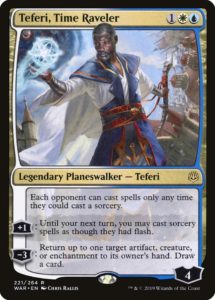
Teferi is back again. Earlier I said that Wizards had a nack for taking popular blue characters and making people dislike them. Teferi, Hero of Dominaria was a contentious card, but Time Raveler is an incredibly oppressive card. It was so oppressive it was banned in Standard and has started causing people to become a bit sick of Teferi, which is a shame. Just like Jace, he’s a perfectly fine character given cards that are decidedly unfun.
-
First Ability:
Teferi, Time Raveler is a 3 CMC 4 Loyalty Blue White Planeswalker from 2019’s War of the Spark, being banned from Standard in August of 2020, 15 months later. Being from War of the Spark, Teferi has a passive ability. Your opponents cannot cast Spells on other player’s turns. No Instants, no Flash, no interruptions. You get to play Magic normally, your opponent gets to play a different game. Your opponent cannot react to anything you do short of activated abilities. At 3 CMC, Teferi warps the board to his will extremely early too.
-
Second Ability:
But Teferi gets better, and by better, I mean worse. His +1 gives all your Sorceries Flash. His passive dumbs down your opponent’s game, his +1 makes your game more tactical. This is why Teferi is so very oppressive. You and your opponent are now playing completely different games with the same core. You have so many choices and tactical options while you tie your opponent’s hands behind their back. It becomes so easy at this point to just dominate them. You’re playing Blue, so chances are you can counterspell your way out of Planeswalker hate, depending on when it’s played.
-
Third Ability:
Finally his -3 bounces an artifact, creature or enchantment and you draw a card. It can have it’s uses, especially if something on board is a huge threat to Teferi and you can protect his now 1 loyalty, but the first two effects are why you play Teferi Time Raveler.
Teferi Time Raveler is the strongest planeswalker in Modern and one of the most powerful Planeswalkers ever printed regardless of format. He completely warps the game of Magic, making it so one sided it’s infuriating to play. He’s arguably stronger than the infamous Jace, the Mind Scupltor, though many times you’ll actually be playing him in tandem with Jace or his prior form, Teferi, Hero of Dominaria. Your opponent will learn to hate Blue all over again.




